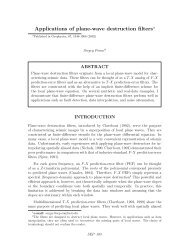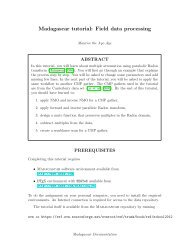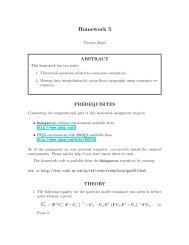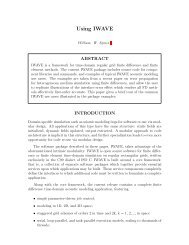Seismic wave extrapolation using lowrank symbol ... - Madagascar
Seismic wave extrapolation using lowrank symbol ... - Madagascar
Seismic wave extrapolation using lowrank symbol ... - Madagascar
You also want an ePaper? Increase the reach of your titles
YUMPU automatically turns print PDFs into web optimized ePapers that Google loves.
Fomel, Ying, & Song 4 Lowrank <strong>wave</strong> <strong>extrapolation</strong><br />
for a fixed ∆t into a separated representation<br />
W (x, k) ≈<br />
M∑<br />
m=1 n=1<br />
N∑<br />
W (x, k m )a mn W (x n , k). (12)<br />
Representation (12) speeds up the computation of P (x, t + ∆t) since<br />
∫<br />
P (x, t + ∆t) = e ixk W (x, k) ̂P (k, t)dk<br />
(<br />
M∑<br />
∑ N (∫<br />
≈ W (x, k m ) a mn e ixk W (x n , k) ̂P (k, t)dk) ) . (13)<br />
m=1<br />
n=1<br />
The evaluation of the last formula is effectively equivalent to applying N inverse Fast<br />
Fourier Transforms. Physically, a separable <strong>lowrank</strong> approximation amounts to selecting<br />
a set of N representative spatial locations and M representative <strong>wave</strong>numbers.<br />
In order to discuss the construction of approximation (12), let us view it as a<br />
matrix decomposition problem<br />
W ≈ W 1 A W 2 (14)<br />
where W is the N x ×N x matrix with entries W (x, k), W 1 is the submatrix of W that<br />
consists of the columns associated with {k m }, W 2 is the submatrix that consists of the<br />
rows associated with {x n }, and A = {a mn }. In practice, we find that the matrix W<br />
has a low rank separated representation provided that ∆t is sufficiently small, which,<br />
in the case of smooth models, can be partially explained by the separation of terms in<br />
the Taylor series 5. Let ε be a prescribed accuracy of this separated representation,<br />
and r ε be the numerical rank of W. The construction of the separated representation<br />
in equation (14) follows the method of Engquist and Ying (2007, 2009) and is detailed<br />
in the appendix. The main observation is that the columns of W 1 and the rows of W 2<br />
should span the column space and row space of W, respectively, as well as possible.<br />
The algorithm for computing (14) takes the following steps:<br />
1. Pick a uniformly random set S of β · r ε columns of W where β is chosen to be<br />
3 or 4 in practice. Perform the pivoted QR factorization to (W(:, S)) ∗ (Golub<br />
and Van Loan 1996). The first r ε pivoted columns correspond to r ε rows of the<br />
matrix W(:, S). Define W 1 to be the submatrix of W that consists of these<br />
rows and set x 1 , . . . , x N with n = r ε to be the corresponding x values of these<br />
rows.<br />
2. Pick a uniformly random set T of β · r ε rows of W and perform the pivoted QR<br />
factorization to W(T, :). Define W 2 to be the submatrix of W that consists of<br />
these columns and set k 1 , . . . , k M with m = r ε to be the corresponding k values<br />
of these columns.<br />
3. Set the middle matrix A = W † (x n , k m ) 1≤n≤N,1≤m≤M where † stands for the<br />
pseudoinverse.











